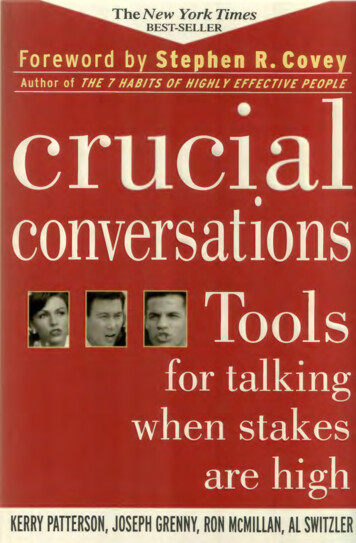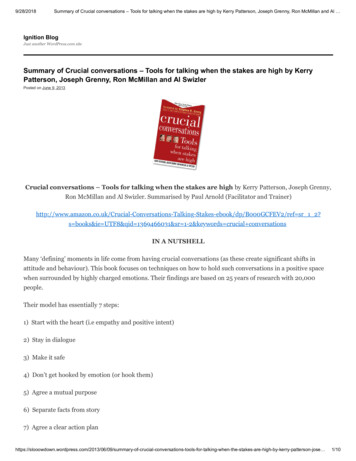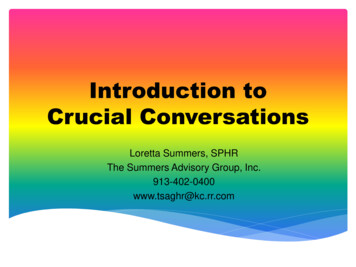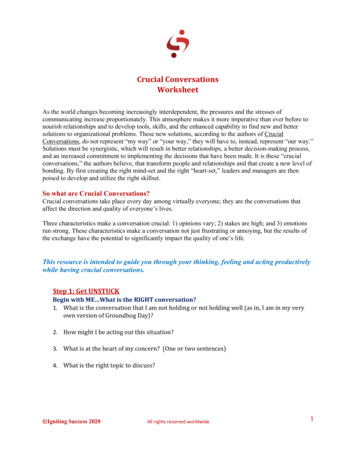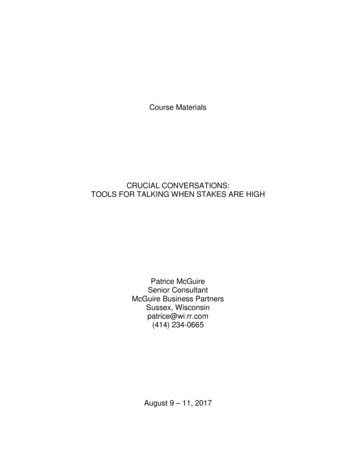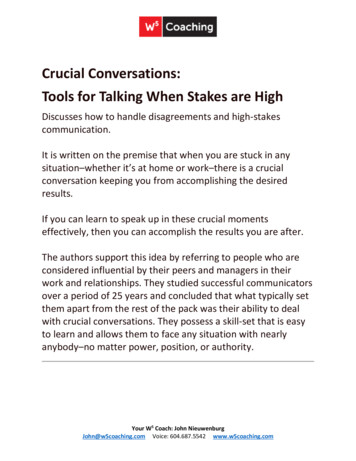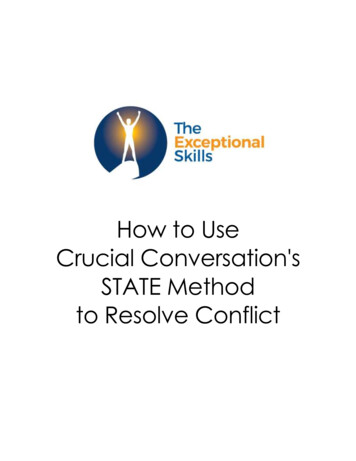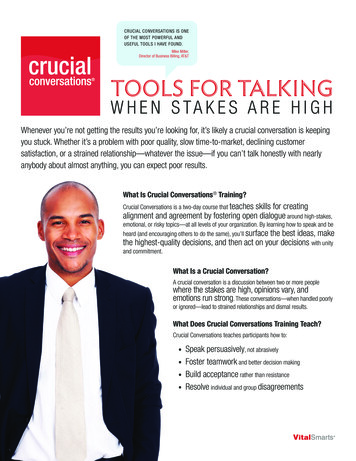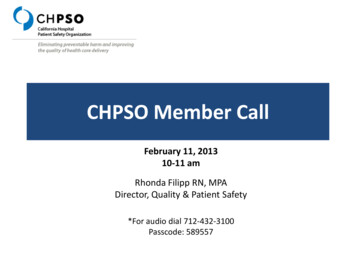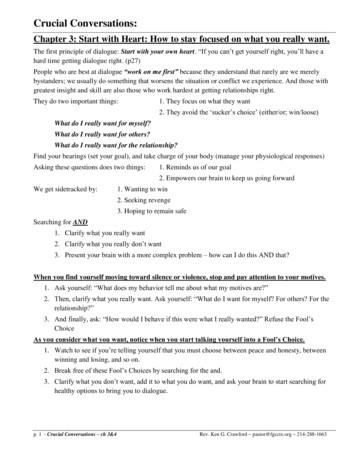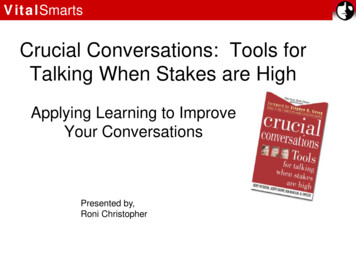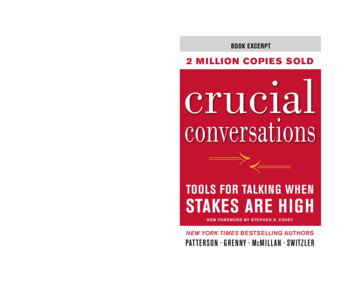
Transcription
not for resalebook excerptThe New York Times bestseller thatchanged the way millions communicate2 m i llion copi es soldBusiness/Self-Help“[Crucial Conversations] draws our attention to those defining moments that literallyshape our lives, our relationships, and our world. . . . This book deserves to take its placeas one of the key thought leadership contributions of our time.”—From the Foreword by Stephen R. Covey, author ofThe 7 Habits of Highly Effective People“The quality of your life comes out of the quality of your dialogues and conversations.Here’s how to instantly uplift your crucial conversations.”—Mark Victor Hansen, cocreator of the #1 New York Timesbestselling series Chicken Soup for the Soul The first edition of Crucial Conversations exploded onto the scene and revolutionizedthe way millions of people communicate when stakes are high. This new edition givesyou the tools to:····Prepare for high-stakes situationsTransform anger and hurt feelings into powerful dialogueMake it safe to talk about almost anythingBe persuasive, not abrasiveKerry Patterson, Joseph Grenny,Ron McMillan, and Al Switzler arecofounders of VitalSmarts, an innovatorin corporate training and alconversationsTools for Talking WhenAlso from the bestselling authorsat VitalSmartsStakes are HighN ew For ewor d by Ste p h e n R. C oveynew York Times Bestselling AuthorsTMPatterson Grenny M c Millan Switzler
01(a-d-i-xviii-001-250) book:Patterson8/2/113:46 PMPage d
Take the VitalSmarts1ST CHAPTER CHALLENGE1. Read the first chapter of our New York Times bestseller:Crucial Conversations2. Ask yourself: “Do I, my team, or my organization face challengesthat require high-stakes, political, or risky conversations?”If yes, then 3. Ask yourself: “Do I, my team, or my organization have thenecessary skills to hold these conversations successfully?”If no, then 4. Master these conversations. VitalSmarts brings you award-winning training programs that drive the results you care about.Contact us today: 1.800.449.5989 www.vitalsmarts.comYou will be receiving our award-winning weekly e-publication, The Crucial Skills Newsletter. The newsletter is free, and you have the option to unsubscribe at any time.
PRAISE FOR CRUCIAL CONVERSATIONS“Relationships are the priority of life, and conversations arethe crucial element in profound caring of relationships. Thisbook helps us to think about what we really want to say. If youwant to succeed in both talking and listening, read this book.”–Dr. Lloyd J. Ogilvie, chaplain, United States Senate“Important, lucid, and practical, Crucial Conversations is a bookthat will make a difference in your life. Learn how to flourish inevery difficult situation.”–Robert E. Quinn, ME Tracy Collegiate Professor ofOBHRM, University of Michigan Business School“I was personally and professionally inspired by this book—and I’m not easily impressed. In the fast-paced world of IT, thesuccess of our systems, and our business, depends on crucialconversations we have every day, Unfortunately, because ourenvironment is so technical, far too often we forget about the‘human systems’ that make or break us. These skills are the missing foundation piece.”–Maureen Burke, manager of training,Coca-Cola Enterprises, Inc.“The book is compelling, Yes, I found myself in too many of theirexamples of what not to do when caught in these worst-of-allworld situations! GET THIS BOOK, WHIP OUT A PEN ANDGET READY TO SCRIBBLE MARGIN NOTES FURIOUSLY,AND PRACTICE, PRACTICE, PRACTICE THE INVALUABLETOOLS THESE AUTHORS PRESENT. I know I did—and ithelped me salvage several difficult situations and repair my damaged self-esteem in others. I will need another copy pretty soon, asI’m wearing out the pages in this one!”–James Belasco, best-selling author of Flight of the Buffalo,entrepreneur, professor, and executive director of the FinancialTimes Knowledge Dialogue
“Crucial Conversations is the most useful self-help book I haveever read. I’m awed by how insightful, readable, well organized,and focused it is. I keep thinking: ‘If only I had been exposed tothese dialogue skills 30 years ago.’”–John Hatch, founder, FINCA International“One of the greatest tragedies is seeing someone with incredible talent get derailed because he or she lacks some basic skills.Crucial Conversations addresses the number one reason executives derail, and it provides extremely helpful tools to operate in afast-paced, results-oriented environment.”–Karie A. Willyerd, chief talent officer, Solectron“This book prescribes with structure and wit, a way to improveon the most fundamental element of organization learning andgrowth—honest, unencumbered dialogue between individuals. There are one or two of the many leadership/management‘thought’ books on my shelf that are frayed and dog-eared fromuse. Crucial Conversations will no doubt end up in the samecondition.”–John Gill, VP of Human Resources, Rolls Royce USA
01(a-d-i-xviii-001-250) book:Patterson8/2/113:46 PMPage d
01(a-d-i-xviii-001-250) book:Patterson8/2/113:46 PMPage iCrucialConversationsTools for TalkingWhen Stakes Are HighSECOND EDITIONKerry Patterson, Joseph Grenny,Ron McMillan, Al SwitzlerNew York Chicago San Francisco Lisbon London Madrid Mexico CityMilan New Delhi San Juan Seoul Singapore Sydney Toronto
01(a-d-i-xviii-001-250) book:Patterson8/2/113:46 PMPage iiCopyright 2012 by Kerry Patterson, Joseph Grenny, Ron McMillan,and Al Switzler. All rights reserved. Printed in the United States ofAmerica. Except as permitted under the United States Copyright Act of1976, no part of this publication may be reproduced or distributed inany form or by any means, or stored in a database or retrieval system,without the prior written permission of the publisher.1 2 3 4 5 6 7 8 9 10DOC/DOC 1 6 5 4 3 2 1ISBN978-0-07-177132-0 (paperback)MHID0-07-177132-8 (paperback)ISBN978-0-07-177530-4 (hardcover)MHID0-07-177530-7 (hardcover)e-ISBN 978-0-07-177220-4e-MHID 0-07-177220-0e-ISBN 978-0-07-178494-8 (enhanced)e-MHID 0-07-178494-2 (enhanced)McGraw-Hill books are available at special quantity discounts to useas premiums and sales promotions. To contact a representative, pleasee-mail us at bulksales@mcgraw-hill.com.This book is printed on acid-free paper.
01(a-d-i-xviii-001-250) book:Patterson8/2/113:46 PMPage vContentsF OREWORDTO THEF OREWORDS ECOND E DITION viiTO THEF IRST E DITION ixP REFACE xiiiA CKNOWLEDGMENTS xviiCH. 1: What’s a Crucial Conversation?And Who Cares? 1CH. 2: Mastering Crucial ConversationsThe Power of Dialogue 19CH. 3: Start with HeartHow to Stay Focused on What You Really Want 33CH. 4: Learn to LookHow to Notice When Safety Is at Risk 51CH. 5: Make It SafeHow to Make It Safe to Talk About Almost Anything 73CH. 6: Master My StoriesHow to Stay in Dialogue When You’re Angry,Scared, or Hurt 103v
01(a-d-i-xviii-001-250) book:Pattersonvi8/2/113:46 PMPage viCONTENTSCH. 7: STATE My PathHow to Speak Persuasively, Not Abrasively 131CH. 8: Explore Others’ PathsHow to Listen When Others Blow Up or Clam Up 155CH. 9: Move to ActionHow to Turn Crucial Conversationsinto Action and Results 177CH. 10: Yeah, ButAdvice for Tough Cases 189CH. 11: Putting It All TogetherTools for Preparing and Learning 211AfterwordWhat I’ve Learned About Crucial Conversationsin the Past Ten Years 223E NDNOTES 231I NDEX 233
01(a-d-i-xviii-001-250) book:Patterson8/2/113:46 PMPage viiForeword to the Second EditionNo one is more pleased than I am that as I write this, this important book is approaching two million copies in print. I learned alot from this book ten years ago when the authors first sent methe manuscript. For years I have taught Habit 5: Seek First toUnderstand. But this book goes even broader and deeper into thefundamental principles of high-stakes communication. It dealswith the whole dynamic of crucial conversations in a wonderfully comprehensive way. But even more important, it draws ourattention to those defining moments that literally shape our lives,shape our relationships, and shape our world. And that’s whythis book deserves to take its place as one of the key thoughtleadership contributions of our time.Furthermore, I am gratified at this book’s influence, becauseI have known these four authors for many years. They aresuperior people, great teachers, and master trainers. They havecreated a remarkably synergistic team that has endured for overtwenty years. That says a lot about their ability to have crucialconversations themselves. In addition, they have created a worldclass organization, VitalSmarts, that has become an engine ofleadership, relationship, and personal change material that hasinfluenced many millions of lives around the world. The culturevii
01(a-d-i-xviii-001-250) book:Pattersonviii8/2/113:46 PMPage viiiFOREWORD TO THE SECOND EDITIONof their organization is a stellar reflection of all they teach inthis volume—and is evidence of the efficacy of these principles.I write this with my best wishes that the work of this fine teamwill continue to influence the world for many years to come.— Stephen R. CoveyJuly 2011
01(a-d-i-xviii-001-250) book:Patterson8/2/113:46 PMPage 11The single biggest problem in communication isthe illusion that it has taken place.—G EORGE B ERNARD S HAWWhat’s a CrucialConversation?And Who Cares?When people first hear the term “crucial conversation,” manyconjure up images of presidents, emperors, and prime ministersseated around a massive table while they debate the future.Although it’s true that such discussions have a wide-sweepingimpact, they’re not the kind we have in mind. The crucial conversations we’re referring to are interactions that happen to everyone. They’re the day-to-day conversations that affect your life.Now, what makes one of your conversations crucial asopposed to plain vanilla? First, opinions vary. For example,you’re talking with your boss about a possible promotion. Shethinks you’re not ready; you think you are. Second, stakes arehigh. You’re in a meeting with four coworkers and you’re tryingto pick a new marketing strategy. You’ve got to do something different or your company isn’t going to hit its annual goals. Third,1
01(a-d-i-xviii-001-250) book:Patterson28/2/113:46 PMPage 2CRUCIAL CONVERSATIONSemotions run strong. You’re in the middle of a casual discussionwith your spouse and he or she brings up an “ugly incident” thattook place at yesterday’s neighborhood block party. Apparentlynot only did you flirt with someone at the party, but according toyour spouse, “You were practically making out.” You don’tremember flirting. You simply remember being polite andfriendly. Your spouse walks off in a huff.And speaking of the block party, at one point you’re makingsmall talk with your somewhat crotchety and always colorfulneighbor about his shrinking kidneys when he says, “Speaking ofthe new fence you’re building . . .” From that moment on youend up in a heated debate over placing the new fence—threeinches one way or the other. Three inches! He finishes by threatening you with a lawsuit, and you punctuate your points by mentioning that he’s not completely aware of the difference betweenhis hind part and his elbow. Emotions run really strong.What makes each of these conversations crucial—and notsimply challenging, frustrating, frightening, or annoying—is thatthe results could have a huge impact on the quality of your life.
01(a-d-i-xviii-001-250) book:Patterson8/2/113:46 PMPage 3WHAT’S A CRUCIAL CONVERSATION?3In each case, some element of your daily routine could be foreveraltered for better or worse. Clearly a promotion could make a bigdifference. Your company’s success affects you and everyone youwork with. Your relationship with your spouse influences everyaspect of your life. Even something as trivial as a debate over aproperty line affects how you get along with your neighbor.Despite the importance of crucial conversations, we often backaway from them because we fear we’ll make matters worse. We’vebecome masters at avoiding tough conversations. Coworkers sende-mail to each other when they should walk down the hall and talkturkey. Bosses leave voice mail in lieu of meeting with their directreports. Family members change the subject when an issue getstoo risky. We (the authors) have a friend who learned through avoice-mail message that his wife was divorcing him. We use allkinds of tactics to dodge touchy issues.Jurassic Sales CallAuthor Joseph Grenny takes you inside the VitalSmarts VideoVault and introduces you to Rick, who is training a new salesassociate. Watch as the new associate, Michael, causes a scene infront of a client. How would you handle this crucial conversation?To watch this video, visit www.CrucialConversations.com/exclusive.But it doesn’t have to be this way. If you know how to handlecrucial conversations, you can effectively hold tough conversations about virtually any topic.–o– shel kän vŭr sa shen) nCrucial Conversation (kroA discussion between two or more people where (1) stakesare high, (2) opinions vary, and (3) emotions run strong.
01(a-d-i-xviii-001-250) book:Patterson48/2/113:46 PMPage 4CRUCIAL CONVERSATIONSHOW DO WE TYPICALLY HANDLE CRUCIALCONVERSATIONS?Just because we’re in the middle of a crucial conversation (ormaybe thinking about stepping up to one) doesn’t mean thatwe’re in trouble or that we won’t fare well. In truth, when weface crucial conversations, we can do one of three things: We can avoid them. We can face them and handle them poorly. We can face them and handle them well.That seems simple enough. Walk away from crucial conversations and suffer the consequences. Handle them poorly and suffer the consequences. Or handle them well.“I don’t know,” you think to yourself. “Given the three choices,I’ll go with handling them well.”When It Matters Most, We Do Our WorstBut do we handle them well? When talking turns tough, do wepause, take a deep breath, announce to our innerselves, “Uh-oh,this discussion is crucial. I’d better pay close attention” and thentrot out our best behavior? Or when we’re anticipating a potentially dangerous discussion, do we step up to it rather than scamper away? Sometimes. Sometimes we boldly step up to hot topics, monitor our behavior, and offer up our best work. We mindour Ps and Qs. Sometimes we’re just flat-out good.And then we have the rest of our lives. These are the momentswhen, for whatever reason, we’re at our absolute worst—we yell;we withdraw; we say things we later regret. When conversationsmatter the most—that is, when conversations move from casualto crucial—we’re generally on our worst behavior.Why is that?
01(a-d-i-xviii-001-250) book:Patterson8/2/113:46 PMPage 5WHAT’S A CRUCIAL CONVERSATION?5We’re designed wrong. When conversations turn from routineto crucial, we’re often in trouble. That’s because emotions don’texactly prepare us to converse effectively. Countless generationsof genetic shaping drive humans to handle crucial conversationswith flying fists and fleet feet, not intelligent persuasion and gentle attentiveness.For instance, consider a typical crucial conversation. Someonesays something you disagree with about a topic that matters agreat deal to you and the hairs on the back of your neck standup. The hairs you can handle. Unfortunately, your body doesmore. Two tiny organs seated neatly atop your kidneys pumpadrenaline into your bloodstream. You don’t choose to do this.Your adrenal glands do it, and then you have to live with it.And that’s not all. Your brain then diverts blood from activities it deems nonessential to high-priority tasks such as hittingand running. Unfortunately, as the large muscles of the arms andlegs get more blood, the higher-level reasoning sections of yourbrain get less. As a result, you end up facing challenging conversations with the same intellectual equipment available to a rhesus monkey. Your body is preparing to deal with an attackingsaber-toothed tiger, not your boss, neighbor, or loved ones.We’re under pressure. Let’s add another factor. Crucial conversations are frequently spontaneous. More often than not, theycome out of nowhere. And since you’re caught by surprise,you’re forced to conduct an extraordinarily complex humaninteraction in real time—no books, no coaches, and certainly noshort breaks while a team of therapists runs to your aid andpumps you full of nifty ideas.What do you have to work with? The issue at hand, the otherperson, and a brain that’s drunk on adrenaline and almost incapable of rational thought. It’s little wonder that we often say anddo things that make perfect sense in the moment, but later onseem, well, stupid.
01(a-d-i-xviii-001-250) book:Patterson68/2/113:46 PMPage 6CRUCIAL CONVERSATIONS“What was I thinking?” you wonder—when what you shouldbe asking is: “What part of my brain was I thinking with?”The truth is, you were real-time multitasking with a brain thatwas working another job. You’re lucky you didn’t suffer a stroke.We’re stumped. Now let’s throw in one more complication.You don’t know where to start. You’re making this up as you goalong because you haven’t often seen real-life models of effectivecommunication skills. Let’s say that you actually planned for atough conversation—maybe you’ve even mentally rehearsed.You feel prepared, and you’re as cool as a cucumber. Will yousucceed? Not necessarily. You can still screw up, because practice doesn’t make perfect; perfect practice makes perfect.This means that first you have to know what to practice.Sometimes you don’t. After all, you may have never actually seenhow a certain problem is best handled. You may have seen whatnot to do—as modeled by a host of friends, colleagues, and, yes,even your parents. In fact, you may have sworn time and againnot to act the same way.Left with no healthy models, you’re now more or lessstumped. So what do you do? You do what most people do. Youwing it. You piece together the words, create a certain mood, andotherwise make up what you think will work—all the while multiprocessing with a half-starved brain. It’s little wonder thatwhen it matters the most, we’re often at our worst behavior.We act in self-defeating ways. In our doped-up, dumbed-downstate, the strategies we choose for dealing with our crucial conversations are perfectly designed to keep us from what we actually want. We’re our own worst enemies—and we don’t evenrealize it. Here’s how this works.Let’s say that your significant other has been paying less andless attention to you. You realize he or she has a busy job, butyou still would like more time together. You drop a few hintsabout the issue, but your loved one doesn’t handle it well. You
01(a-d-i-xviii-001-250) book:Patterson8/2/113:46 PMPage 7WHAT’S A CRUCIAL CONVERSATION?7decide not to put on added pressure, so you clam up. Of course,since you’re not all that happy with the arrangement, your displeasure now comes out through an occasional sarcastic remark.“Another late night, huh? I’ve got Facebook friends I seemore often.”Unfortunately (and here’s where the problem becomes selfdefeating), the more you snip and snap, the less your loved onewants to be around you. So your significant other spends evenless time with you, you become even more upset, and the spiralcontinues. Your behavior is now actually creating the very thingyou didn’t want in the first place. You’re caught in an unhealthy,self-defeating loop.Or consider what’s happening with your roommate Terry—who wears your and your other two roommates’ clothes (without asking)—and he’s proud of it. In fact, one day while walkingout the door, he glibly announced that he was wearing somethingfrom each of your closets. You could see Taylor’s pants, Scott’sshirt, and, yes, even Chris’s new matching shoes-and-socksensemble. What of yours could he possibly be wearing? Eww!Your response, quite naturally, has been to bad-mouth Terrybehind his back. That is, until one day when he overheard youbelittling him to a friend, and you’re now so embarrassed thatyou avoid being around him. Now when you’re out of the apartment, he wears your clothes, eats your food, and uses your computer out of spite.Let’s try another example. You share a cubicle with a four-starslob and you’re a bit of a neat freak. Your coworker has left younotes written in grease pencil on your file cabinet, in catsup on theback of a french-fry bag, and in permanent marker on your deskblotter. You, in contrast, leave him printed Post-it notes. Printed.At first you sort of tolerated each other. Then you began to geton each other’s nerves. You started nagging him about cleaningup. He started nagging you about your nagging. Now you’re
01(a-d-i-xviii-001-250) book:Patterson88/2/113:46 PMPage 8CRUCIAL CONVERSATIONSbeginning to react to each other. Every time you nag, he becomesupset, and, well, let’s say that he doesn’t exactly clean up. Everytime he calls you an “anal-retentive nanny,” you vow not to givein to his vile and filthy ways.What has come from all this bickering? Now you’re neaterthan ever, and your cubicle partner’s half of the work area isabout to be condemned by the health department. You’re caughtin a self-defeating loop. The more the two of you push eachother, the more you create the very behaviors you both despise.Some Common Crucial ConversationsIn each of these examples of unhealthy downward spirals, thestakes were moderate to high, opinions varied, and emotions ranstrong. Actually, to be honest, in a couple of the examples thestakes were fairly low at first, but with time and growing emotions, the relationship eventually turned sour and quality of lifesuffered—making the risks high.These examples, of course, are merely the tip of an enormousand ugly iceberg of problems stemming from crucial conversations that either have been avoided or have gone wrong. Othertopics that could easily lead to disaster include Ending a relationship Talking to a coworker who behaves offensively or makessuggestive comments Asking a friend to repay a loan Giving the boss feedback about her behavior Approaching a boss who is breaking his own safety orquality policies Critiquing a colleague’s work Asking a roommate to move out
01(a-d-i-xviii-001-250) book:Patterson8/2/113:46 PMPage 9WHAT’S A CRUCIAL CONVERSATION?9 Resolving custody or visitation issues with an ex-spouse Dealing with a rebellious teen Talking to a team member who isn’t keeping commitments Discussing problems with sexual intimacy Confronting a loved one about a substance abuse problem Talking to a colleague who is hoarding information or resources Giving an unfavorable performance review Asking in-laws to quit interfering Talking to a coworker about a personal hygiene problemOUR AUDACIOUS CLAIMLet’s say that either you avoid tough issues, or when you dobring them up, you’re on your worst behavior. How high are thestakes? This is just talk, right? Do the consequences of a fouledup conversation extend beyond the conversation itself? Shouldyou worry?Actually, the effects of conversations gone bad can be bothdevastating and far reaching. Our research has shown thatstrong relationships, careers, organizations, and communities alldraw from the same source of power—the ability to talk openlyabout high-stakes, emotional, controversial topics.So here’s the audacious claim:The Law of Crucial ConversationsAt the heart of almost all chronic problems in our organizations, our teams, and our relationships lie crucial conversations—ones that we’re either not holding or not holdingwell. Twenty years of research involving more than 100,000people reveals that the key skill of effective leaders, team-
01(a-d-i-xviii-001-250) book:Patterson108/2/113:46 PMPage 10CRUCIAL CONVERSATIONSmates, parents, and loved ones is the capacity to skillfullyaddress emotionally and politically risky issues. Period.Here are just a few examples of these fascinating findings.Kick-Start Your CareerCould the ability to master crucial conversations help yourcareer? Absolutely. Twenty-five years of research in seventeendifferent organizations has taught us that individuals who arethe most influential—who can get things done and at the sametime build on relationships—are those who master their crucialconversations.For instance, high performers know how to stand up to theboss without committing career suicide. We’ve all seen peoplehurt their careers by ineffectively discussing tough issues. Youmay have done it yourself. Fed up with a lengthy and unhealthypattern of behavior, you finally speak out—but a bit too abruptly.Oops. Or maybe an issue becomes so hot that as your peerstwitch and fidget themselves into a quivering mass of potentialstroke victims, you decide to say something. It’s not a pretty discussion—but somebody has to have the guts to keep the bossfrom doing something stupid. (Gulp.)As it turns out, you don’t have to choose between being honest and being effective. You don’t have to choose between candor and your career. People who routinely hold crucial conversations and hold them well are able to express controversial andeven risky opinions in a way that gets heard. Their bosses, peers,and direct reports listen without becoming defensive or angry.What about your career? Are there crucial conversations thatyou’re not holding or not holding well? Is this underminingyour influence? And more importantly, would your career takea step forward if you could improve how you’re dealing withthese conversations?
01(a-d-i-xviii-001-250) book:Patterson8/2/113:46 PMPage 11WHAT’S A CRUCIAL CONVERSATION?11Improve Your OrganizationIs it possible that an organization’s performance could hang onsomething as soft and gushy as how individuals deal with crucialconversations?Study after study suggests that the answer is yes.We began our work twenty-five years ago looking for what wecalled crucial moments. We wondered, “Are there a handful ofmoments when someone’s actions disproportionately affect keyperformance indicators?” And if so, what are those momentsand how should we act when they occur?It was that search that led us to crucial conversations. Wefound that more often than not, the world changes when peoplehave to deal with a very risky issue and either do it poorly or doit well. For example:Silence kills. A doctor is getting ready to insert a central IVline into a patient but fails to put on the proper gloves, gown,and mask to ensure the procedure is done as safely as possible.After the nurse reminds the doctor of the proper protections, thedoctor ignores her comment and begins the insertion. In a studyof over 7,000 doctors and nurses, we’ve found caregivers facethis crucial moment all the time. In fact, 84 percent of respondents said that they regularly see people taking shortcuts,exhibiting incompetence, or breaking rules.And that’s not the problem!The real problem is that those who observe deviations orinfractions say nothing. Across the world we’ve found that theodds of a nurse speaking up in this crucial moment are less thanone in twelve. The odds of doctors stepping up to similar crucialconversations aren’t much better.And when they don’t speak up, when they don’t hold an effective crucial conversation, it impacts patient safety (some evendie), nursing turnover, physician satisfaction, nursing productivity, and a host of other results.
01(a-d-i-xviii-001-250) book:Patterson128/2/113:46 PMPage 12CRUCIAL CONVERSATIONSSilence fails. When it comes to the corporate world, the mostcommon complaint of executives and managers is that their people work in silos. They do great at tasks that are handled entirelywithin their team. Unfortunately, close to 80 percent of the projects that require cross-functional cooperation cost far more thanexpected, produce less than hoped for, and run significantly overbudget. We wondered why.So we studied over 2,200 projects and programs that hadbeen rolled out at hundreds of organizations worldwide. Thefindings were stunning. You can predict with nearly 90 percentaccuracy which projects will fail—months or years in advance.And now back to our premise. The predictor of success or failure was whether people could hold five specific crucial conversations. For example, could they speak up if they thought thescope and schedule were unrealistic? Or did they go silent whena cross-functional team member began sloughing off? Or evenmore tricky—what should they do when an executive failed toprovide leadership for the effort?In most organizations, employees fell silent when these crucialmoments hit. Fortunately, in those organizations where peoplewere able to candidly and effectively speak up about these concerns, the projects were less than half as likely to fail. Onceagain, the presenting problems showed up in key performanceindicators such as spiraling costs, late delivery times, and lowmorale. Nevertheless, the underlying cause was the unwillingness or inability to speak up at crucial moments.Other important studies we’ve conducted (read the completestudies at www.vitalsmarts.com/research have shown that companies with employees who are skilled at crucial conversations: Respond five times faster to financial downturns—and makebudget adjustments far more intelligently than less-skilledpeers (Research Study: Financial Agility).
01(a-d-i-xviii-001-250) book:Patterson8/2/113:46 PMPage 13WHAT’S A CRUCIAL CONVERSATION?13 Are two-thirds more likely to avoid injury and death due tounsafe conditions (Research Study: Silent Danger). Save over 1,500 and an eight-hour workday for every crucialconversation employees hold rather than avoid (ResearchStudy: The Costs of Conflict Avoidance). Substantially increase trust and reduce transaction costs invirtual work teams. Those who can’t handle their crucialconversations suffer in thirteen different ways (backstabbing,gossip, undermining, passive aggression, etc.) as much asthree times more often in virtual tea
Crucial Conversations addresses the number one reason execu-tives derail, and it provides extremely helpful tools to operate in a fast-paced, results-oriented environment.” –Karie A. Willyerd, chi
